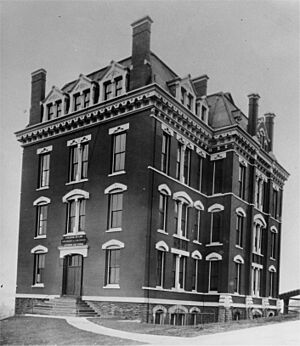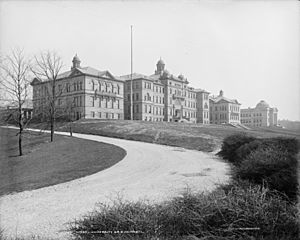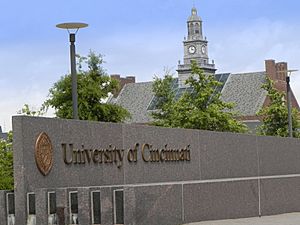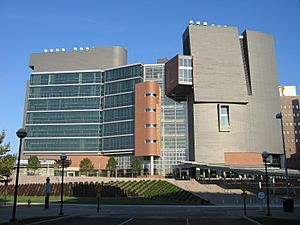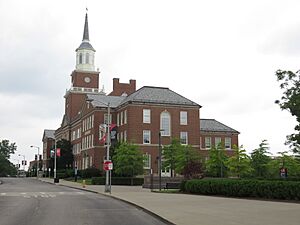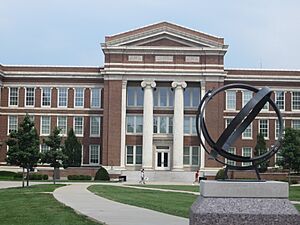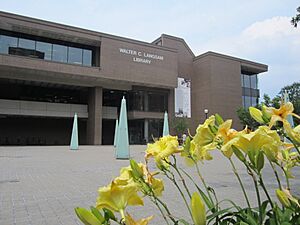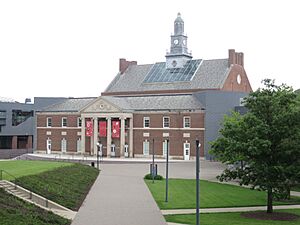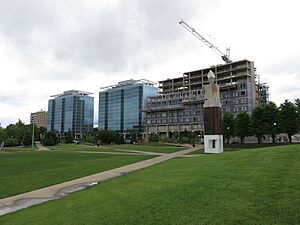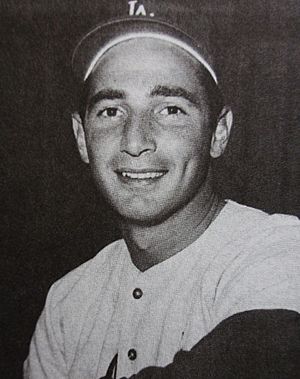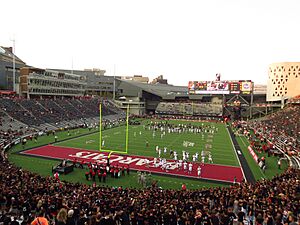University of Cincinnati facts for kids
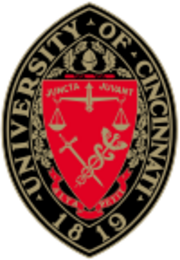 |
|
|
Former names
|
List
Cincinnati College (1819–1825; 1835–1870)
Medical College of Ohio (1819–1896) Cincinnati Law School (1833–1893) Miami Medical College (1852–1909) Cincinnati Conservatory of Music (1867–1955) College of Music of Cincinnati (1878–1955) Cincinnati College-Conservatory of Music (1955–1962) |
|---|---|
| Motto | Juncta Juvant (Latin) Alta Petit (Latin) |
|
Motto in English
|
"Strength in Unity" "Seek the Highest" |
| Type | Public research university |
| Established | 1819 |
|
Parent institution
|
University System of Ohio |
| Accreditation | HLC |
|
Academic affiliations
|
|
| Endowment | $2.0 billion (2024) |
| President | Neville G. Pinto |
| Provost | John W. Weidner (interim) |
|
Academic staff
|
3,789 full-time, 2,976 part-time (2024) |
|
Administrative staff
|
4,786 full-time, 314 part-time (2024) |
| Students | 53,235 (2024) |
| Undergraduates | 41,223 (2024) |
| Postgraduates | 12,012 (2024) |
| Location |
,
,
United States
39°7′58″N 84°30′55″W / 39.13278°N 84.51528°W |
| Campus | Large city, Main campus: 202 acres (0.82 km2) Uptown campus (Main and Medical): 194 acres (0.79 km2) All campuses: 473 acres (1.91 km2) |
| Other campuses |
|
| Newspaper | The News Record |
| Colors | Red and black |
| Nickname | Bearcats |
|
Sporting affiliations
|
NCAA Division I FBS – Big 12 |
| Mascot | The Bearcat |
 |
|
The University of Cincinnati (often called UC or Cincy) is a large public university in Cincinnati, Ohio, United States. It started in 1819 and is now one of the biggest universities in Ohio. In 2024, over 53,000 students attended UC. It is part of the University System of Ohio. The main campus is in the Heights and Corryville areas of Cincinnati. There are also branch campuses in Batavia and Blue Ash, Ohio.
UC has 14 different colleges. These colleges offer programs in many subjects like architecture, business, education, engineering, arts and sciences, law, music, and medicine. The medical college has a top teaching hospital and research labs. Important discoveries made here include a live polio vaccine and diphenhydramine (a medicine). UC was also the first university to use a special learning method called co-operative education (co-op).
The university is a "top research university," meaning it does a lot of important studies. UC's sports teams are called the Cincinnati Bearcats. They play in NCAA Division I as part of the Big 12 Conference.
Contents
History of the University of Cincinnati
How UC Started
In 1819, two schools were founded in Cincinnati: Cincinnati College and the Medical College of Ohio. A local helper named Daniel Drake started the Medical College of Ohio. William Lytle gave the land and money for Cincinnati College and its Law College. He was also its first leader. Cincinnati College closed after six years because of money problems. But in 1835, Daniel Drake reopened it. Later, it joined with the Cincinnati Law School.
In 1858, Charles McMicken passed away. He left most of his money to the City of Cincinnati to start a university. The Ohio government officially created the University of Cincinnati in 1870. The university's leaders then changed its name to the University of Cincinnati.
Growing Through the Years
By 1893, the university had grown and moved to its current spot in the Heights neighborhood. As it grew, the leaders combined it with Cincinnati Law School. This created the University of Cincinnati College of Law. In 1896, the Ohio Medical College joined with Miami Medical College. They formed the Ohio-Miami Medical Department of the University of Cincinnati in 1909.
The university also started a Teacher's College in 1905 and a Graduate School in 1906. The Queen City College of Pharmacy also became part of UC. In 1962, the Cincinnati College-Conservatory of Music joined the university. In 1971, UC was one of the first universities to offer a course about women's studies.
UC Today
In 1977, the University of Cincinnati officially became a state university in Ohio. In 1989, President Joseph A. Steger created a plan to make the university even better. UC spent a lot of money to build new buildings and update old ones. This included new student centers and a recreation center. The plan also added green spaces like the Sigma Sigma Commons, finished in 1998.
In 2005, President Nancy L. Zimpher started the UC21 plan. This plan aimed to make Cincinnati a top urban research university. It focused on liberal arts, increasing research money, and helping the city. Gregory H. Williams became president in 2009. He worked to keep the university strong and focused on its academic programs. Neville Pinto is the current president.
In 2022, the university removed Charles McMicken's name from campus buildings. This was done because McMicken had owned enslaved people. On June 24, 2025, the university announced changes to some of its cultural centers. The LGBTQ Center, Women's Center, African American Cultural and Resource Center, and Ethnic Programs and Services were closed.
University Campuses
Main Campus Areas
The Uptown campus has three parts: West, Medical, and Victory Parkway. The West campus is the main one. It has 62 buildings on 137 acres (0.55 km2) in the Heights neighborhood. The university moved here in 1893. Most undergraduate colleges are on this main campus.
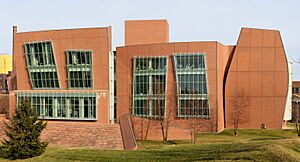
The medical campus has 19 buildings on 57 acres (230,000 m2) in the Corryville neighborhood. It is across from the West campus. Colleges like Allied Health Sciences, Nursing, Medicine, and Pharmacy are here. Hospitals like University of Cincinnati Medical Center are also on this campus.
The Victory Parkway campus is about 3 miles (4.8 km) from the main campus. It used to be home to the College of Applied Science. Many classes moved to the main campus, but some are still taught here. A shuttle bus connects this campus to the main one.
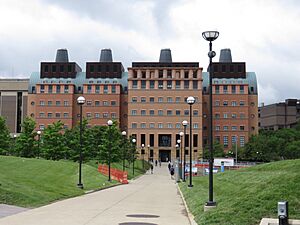
Many buildings at UC were designed by famous architects. This makes the campus known for its beauty and design.
- Crosley Tower (1969)
- Engineering Research Center (1994)
- Aronoff Center for Art and Design (1996)
- College-Conservatory of Music (1999)
- Vontz Center for Molecular Studies (1999)
- Tangeman University Center (2004)
- Steger Student Life Center (2005)
- Campus Recreation Center (2006)
- Lindner Athletic Center (2006)
- Care/Crawley Building (2008)
Other Campuses and Online Learning
UC has two regional campuses. Blue Ash College started in 1967 in Blue Ash, Ohio. Clermont College opened in 1972 in Batavia, Ohio. Both offer associate's and bachelor's degrees. Students can start at these campuses and then move to the main campus to finish their degree.
UC Online offers over 120 programs that students can take from home using an online learning platform.
Being Green and Sustainable
Since 2010, the University of Cincinnati has been named one of the "Green Colleges" by The Princeton Review. This means UC is good at being environmentally friendly. UC was the only public university in Ohio on this list for many years.
Some of UC's green programs include:
- A bike share program for students.
- More recycling options.
- Better campus transportation.
- Using fuel pellets instead of coal.
- Saving a lot of energy and water.
- Having six buildings certified as "green" since 2005.
In 2007, the university president promised to reduce UC's environmental impact. In 2010, UC opened a new athletic facility with a special water tank underground. This tank chills water at night to cool buildings during the day, saving about $1 million each year. UC also added "All Recycling" bins across campus, helping to recycle more materials. In 2010, UC recycled over 4,600 tons of material.
Academics at UC
How to Get In
| Admissions statistics | |
|---|---|
|
2023 entering
classChange vs. 2018 |
|
| Admit rate | 87.7%
(
|
| Yield rate | 23.8%
(
|
| Test scores middle 50%* | |
| SAT Total | 1160–1340 (among 11% of FTFs) |
| ACT Composite | 24–29 (among 36% of FTFs) |
| High school GPA | |
| Average | 3.7 |
|
|
Getting into the University of Cincinnati is considered "selective." This means they look closely at many things when you apply. UC accepts about 87.7% of students who apply.
For students who get in, the average high school GPA is 3.7. Most students who submit test scores have SAT scores between 1160 and 1340. ACT scores are usually between 24 and 29.
UC's Reputation and Rankings
| ARWU World | 301–400 |
|---|---|
| USNWR National University | 152 (tie) |
| Washington Monthly National University | 310 |
In 2025, U.S. News & World Report ranked UC's undergraduate program 152nd among all national universities. It was ranked 81st among public national universities. U.S. News also ranked UC fifth for its co-op and internship programs. Globally, UC was ranked 210th among universities.
Colleges and Programs
The university has 14 colleges:
- College of Allied Health Sciences
- College of Arts and Sciences
- Carl H. Lindner College of Business
- College-Conservatory of Music
- College of Cooperative Education and Professional Studies
- College of Design, Architecture, Art, and Planning
- College of Education, Criminal Justice, and Human Services
- College of Engineering and Applied Science
- Graduate College
- College of Law
- College of Medicine
- College of Nursing
- James L. Winkle College of Pharmacy
The College of Arts and Sciences is the biggest college at UC. It has many departments and programs. At the College of Engineering and Applied Science, Winston Koch invented the first electronic organ. The College of Law is where William Howard Taft, who later became the 27th U.S. president and 10th chief justice, studied. He was also the dean of the college.
The College of Medicine is UC's medical school. It has a leading teaching hospital and research labs. In the 1950s, Albert Sabin developed the live polio vaccine here. Diphenhydramine (known as Benadryl) was also created here by George Rieveschl in 1946. UC also started the first emergency medicine training program.
UC also has two regional campuses: Blue Ash College and Clermont College.
Co-operative Education (Co-Op)
The University of Cincinnati was the first to create the co-operative education (Co-Op) model. This idea was started in 1906 by Herman Schneider, who was the Dean of the College of Engineering. In a co-op program, students spend alternating semesters taking classes and working at a company. This gives them over a year of real work experience before they graduate. Many programs, especially in engineering, architecture, and design, require co-op experience to graduate.
University Honors Program
Each year, about 375 students join the University Honors Program. These are usually the top 5–8% of students. To get in, students typically need an ACT score of 32 or higher, an SAT score of 1400 or higher, and a high school GPA of 3.6 or higher.
The program focuses on students having "experiences." These experiences fit into five areas: community involvement, creativity, global studies, leadership, and research. Students can take special Honors Seminars, join pre-approved programs, or design their own experiences. Students must complete at least five experiences before they graduate.
Research at UC
UC is known as a "top research university." This means it does a lot of important research. In 2018, UC spent $480 million on research and development. This ranked it 54th in the nation for research spending.
University Libraries
The University of Cincinnati has 13 libraries in 11 different buildings. The university library system has over 4 million books and 70,000 magazines and journals. The main library is the Walter C. Langsam Library. UC is part of the OhioLINK group of libraries, which lets students borrow books from many other Ohio colleges.
Student Life
| Race and ethnicity | Total | ||
|---|---|---|---|
| White | 74% |
|
|
| Black | 7% |
|
|
| Other | 7% |
|
|
| Asian | 5% |
|
|
| Hispanic | 4% |
|
|
| Foreign national | 4% |
|
|
| Economic diversity | |||
| Low-income | 18% |
|
|
| Affluent | 82% |
|
|
Student Housing

About 6,500 students live on campus in ten residence halls. These halls offer different room styles. Students can also choose to live in themed housing, like floors just for honors students or those studying business or STEM subjects. In 2012, the Campus Recreation Center Housing was named one of the "10 Public Colleges with Insanely Luxurious Dorms." Almost 80% of new students live on campus their first year.
Because more students want to live on campus, UC has added more residence halls. They also rent apartments nearby for students. UC's largest residence hall, Calhoun, was recently updated. Siddall Hall is also being updated and will reopen in August 2024.
UC also has some housing for graduate students. Bellevue Gardens is an apartment complex owned by the university, close to the medical campus.
Student Programs
The Center for First-Year Experience helps new students adjust to college life. It works with all the colleges and student groups to support freshmen.
Learning communities are groups of about 20–25 students and teachers. Students in these groups take two classes together during their first year. These classes are based on their major. There are almost 120 learning communities to choose from. Some majors require freshmen to join these groups.
The Transition and Access Program helps adults with disabilities take classes and intern at companies. After four years, they get a certificate. UC is also known for being a university that focuses on helping its community.
Student Groups
Student Activities & Leadership Development (SALD) helps manage over 550 student groups. These groups include student government, religious groups, and spirit groups. Other student life offices include the African American Cultural & Resource Center and the Wellness Center.
Greek Life
Fraternities and sororities have been at UC since 1840. Over 2,500 students are part of these groups. There are 39 social fraternities and sororities at UC.
Student Media
UC students have several media outlets. The News Record is the student newspaper. It has been published for over 130 years. It is run by students and is open to any student. Bearcast is a student-run radio station located in the College-Conservatory of Music. It streams online. There is also a student television station called UCast.
Athletics
The university competes in 19 Division I (NCAA) sports. Its teams are called the "Bearcats." Since July 1, 2023, they have been part of the Big 12 Conference. Before that, they were in other conferences like the American Athletic Conference.
UC also has many club sports. Some are even called Club Varsity, like the Bearcat hockey team.
Famous Cincinnati Bearcats athletes include Sandy Koufax, Oscar Robertson, Kenyon Martin, Travis Kelce, and Jason Kelce.
National Championships
The university has won four individual and six team championships. The Bearcats won the NCAA Men's Division I Basketball Championship in 1961 and 1962. Both times, they beat the Ohio State Buckeyes.
In swimming, Charles Keating won a national title in 1946, and Josh Schneider won one in 2010. In women's diving, Pat Evans (1989) and Becky Ruehl (1996) won titles. The UC dance team has won four National Championships (2004, 2005, 2006, and 2009). They are the first UC team to win three national titles in a row. In 2009, the dance team also won gold medals at the first world dance championships.
Athletic Facilities
Most of UC's athletic facilities are open 24/7 for students. The Richard E. Lindner Varsity Village opened in 2006. It is the main area for UC's sports facilities. It includes the Richard E. Lindner Center, which has training areas, meeting rooms, and classrooms. It also has the George and Helen Smith Athletics Museum.
Other important sports places include:
- Gettler Stadium: Home to the soccer team.
- Trabert-Talbert Tennis Center: For the women's tennis team.
- UC Baseball Stadium: For the baseball team.
- Sheakley Lawn: An open field for students.
Nippert Stadium is where the Cincinnati Bearcats football team plays. A new Indoor Practice Facility & Performance Center is being built for the football team. It started in April 2023 and should be finished by spring 2025.
The UC Baseball Stadium is the home field for the baseball team. In 2020, the name of former Cincinnati Reds owner Marge Schott was removed from the stadium.
The Armory Fieldhouse is for UC's indoor track and field teams. Fifth Third Arena is where the men's and women's basketball teams and the volleyball team play. The Keating Aquatics Center is home to the swimming and diving teams.
Notable People from UC
See also
 In Spanish: Universidad de Cincinnati para niños
In Spanish: Universidad de Cincinnati para niños


